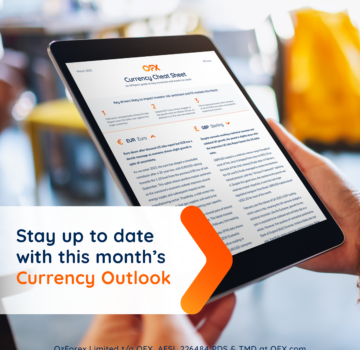In the dynamic landscape of global business, expanding beyond borders can be a strategic move to reach new markets and unlock growth opportunities.
However, with this expansion comes the inevitable challenge of dealing with foreign exchange (FX) risk, which can significantly impact your business’s bottom line.

On this page
Understanding the 3 types of foreign exchange risk
What happens when risk is handled badly?
Hedge your currency exposure with OFX
Understanding the 3 types of foreign exchange risk
Foreign exchange risk, often referred to as currency risk or forex risk, arises from the fluctuations in exchange rates between different currencies.
These fluctuations can affect the value of your international transactions, impacting profits, costs, and overall financial performance. To effectively manage foreign exchange risk, it’s crucial to understand the three main types:
1. Transaction risk
Transaction risk, also known as short-term risk, can occur when a business engages in international trade involving payment or receipt of foreign currency.
This type of risk is particularly relevant for companies importing/exporting goods or services across borders.
Because exchange rates can fluctuate between the transaction and settlement dates, it can lead to gains or losses for your business.
For example, a US company with operations in Germany would need to bring their euro earnings to the US account. If the exchange rate was 1.20 USD to 1 euro at the point of sale but the US exchange rate fell to 1.00 USD before the payment settlement, that expected US$1,200 would instead be only US$1,000.
This example is only a small amount but if you’re dealing in hundreds of thousands or millions, you can see how it could impact your business, potentially eroding your profit margins.
Mitigating transaction risk can often be done by using Forward Contracts. This method allows you to lock in the exchange rate, so you have more control over the amounts you pay or receive.
2. Economic risk
Economic risk, also known as long-term risk or forecast risk, refers to the impact of unavoidable exposure to currency fluctuations and shifts in the economic landscape.
This risk is particularly relevant for companies with long-term investments or contracts in foreign markets.
It stems from the broader impact of exchange rate fluctuations on a business’s future cash flows, investments, and overall competitiveness.
Macroeconomic conditions like exchange rates, government regulations and geopolitical stability can create economic risk. It’s one of the reasons why international investment can be more risky than domestic investment and it typically affects the shareholders and bondholders of a company.
An example of this risk would be if your business plans to make a significant investment in a foreign market. If the local currency depreciates, it could lead to reduced returns on your investment, affecting your long-term profitability.
3. Translation risk
Translation risk, also known as accounting risk, refers to a situation where a parent company owns a subsidiary in another country and the subsidiary’s revenue or profits are converted to the parent company’s currency at a lower value.
When a business operates in multiple countries, it may need to convert the financial results of its foreign subsidiaries into the reporting currency. Because exchange rates fluctuate constantly, there can often be variances in the reported figures between quarterly financial statements, which can impact a company’s stock price.
For example, if your business has a subsidiary in a country with a weakening currency, the translated value of its earnings in your reporting currency may decrease, affecting the overall financial health of your company.
Get in touch to learn more about OFX can help you protect your business against FX risk. Contact us.
What happens when risk is not handled properly?
Now that we’ve explored the types of foreign exchange risk, let’s discuss the tangible impact on your business’s bottom line.
Unmanaged currency risk can result in increased costs, decreased profitability, and financial uncertainty. The unpredictability of exchange rate movements can make it challenging for businesses to plan and budget effectively, leading to potential setbacks in their financial performance.
A 2023 currency risk impacts survey of North American and European companies found that the collective negative impact of the 1,200 surveyed, totalled US$30.26 billion in Q4 2022.
The importance of partnering with a reliable currency exchange service becomes evident.
What economic factors are impacting key currencies? Read our monthly Currency Outlook.
Hedge your currency exposure with OFX
Our OFXperts are available 24/7 to help your business achieve its global money transfer goals. Whether you need to pay international suppliers or overseas staff, set a transfer date or protect against moving currency markets. Your OFXpert can help you with your currency needs all in a single place.
By partnering with a global money transfer specialist, like OFX, you can take advantage of our tools for mitigating currency risk.
Forward Contracts, for example, allow you to lock in a favourable exchange rate and then transfer the funds at a later date, even up to 12 months in the future.
Another tool is a Limit Order, which allows you to pick a target rate. The OFXperts monitor the markets for you. If that target rate is reached, we’ll notify you via email or SMS.
Create your FREE account
Why OFX stands out in a crowd
- Competitive Rates
OFX offers competitive exchange rates, ensuring that your business gets more value for every international transaction. By minimising the impact of unfavourable exchange rate movements, OFX helps protect your profit margins. - Transparent Fees
Avoid hidden fees and enjoy transparent pricing with us. Skip unwelcome surprises in your transactions, so you can have more control and better financial planning. - Risk Management Tools
We offer a range of risk management tools, including Forward Contracts* and Limit Orders, allowing your business to proactively manage exposure to currency fluctuations. - Global Reach
Transferring money to over 170 countries and supporting 50+ currencies, we help you access a vast network of markets and facilitate seamless international transactions. This global reach can help you expand your business without being hindered by currency-related challenges.
Start managing your foreign exchange risk today
Understanding and managing foreign exchange risk is essential for businesses engaged in international transactions. By recognising the impact of transaction, translation, and economic risks, you can make informed decisions to safeguard your bottom line.
Choosing a reliable partner like OFX adds an extra layer of protection, offering competitive rates, transparent fees, and effective risk management tools to ensure the success of your global ventures.
Interested in how to manage forex risk in your business?
Try our free tools or speak to an OFXpert.
IMPORTANT: The contents of this blog do not constitute financial advice and are provided for general information purposes only without taking into account the investment objectives, financial situation and particular needs of any particular person. OzForex Limited (trading as OFX) and its affiliated entities make no recommendation as to the merits of any financial strategy or product referred to in the blog. OFX makes no warranty, express or implied, concerning the suitability, completeness, quality or exactness of the information and models provided in this blog.




